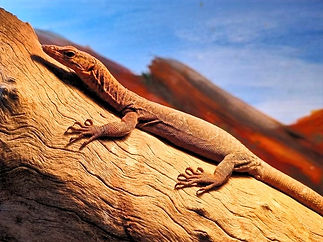

Varanus hamersleyensis
Maryan, Oliver, Fitch & O'Connell (2014)
-Southern Pilbara Rock Monitor

Varanus hamersleyensis, also known as the Southern Pilbara Rock Monitor or Hamersley Range Rock Monitor, is a small-sized monitor species. Adult individuals have a typical snout-vent length (excluding the tail) of up to 170mm, with the tail reaching up to twice the length of the body.
The coloration of Varanus hamersleyensis is a dark red-brown with darker net-like patterning. The pattern is more prominent in adult males and more broken up in adult females. Juveniles also exhibit stronger patterns and colors.
These monitors are found in the south Pilbara region of Western Australia, specifically in the Hamersley Range. They are terrestrial and prefer rock habitats, including gorges, rock faces, and overhangs, particularly in the ironstone-rich areas of the region. The habitat is characterized as dry arid to dry grassland.
Varanus hamersleyensis was considered a rare species in the Australian hobby for many years, but the number of individuals in collections is slowly increasing.
In terms of their behavior, Hamersley Range Rock Monitors have a similar personality to other rock monitors. Once they settle in, they have a relaxed temperament and become well habituated to human interaction and tong feeding. They are very active on a daily basis, exploring their environment, and can do well in small groups. However, care should be taken during feeding time due to their strong feeding response.
Husbandry for Varanus hamersleyensis is relatively easy, as they require only a small to medium-sized enclosure. While they do enjoy climbing rock walls, the enclosure dimensions do not need to be as high as those for arboreal species. Furnishings such as a pile of medium-sized rocks or stacked tiles provide hiding places and add to the attractiveness of the enclosure.
Enclosure size: A minimum enclosure size of 90cm in length and 60cm in depth is recommended for a pair or trio of Hamersley Range Rock Monitors.
Substrate and furnishings: Sand or large pebbles can be used as the substrate, and providing plenty of hides such as hollow logs and stacked flat rocks is important. The availability of tight spaces helps the animals feel secure.
Temperatures and lighting: Adequate UVB lighting is essential, and a basking hot spot should be provided using a bright lamp directed onto a rock or tiled surface, with temperatures ranging from 50-65°C. The ambient heat gradient over the rest of the enclosure should be around 28-33°C during the warmer active months.
Humidity: Although they come from an arid environment, Hamersley Range Rock Monitors benefit from occasional light misting and the provision of a humidity hide.
Feeding: The bulk of their diet should consist of crickets, wood roaches, and other insects, with regular dusting of calcium powder and vitamins. Occasionally, chopped pinkie mice, lean turkey or chicken mince, chopped chicken hearts, boiled chicken eggs, quail eggs, or chopped day-old quail can be added for dietary variety.
Life span: Varanus hamersleyensis is typically recorded as having a lifespan of greater than 8 years in captivity.